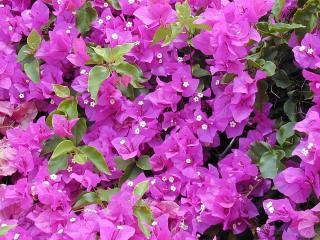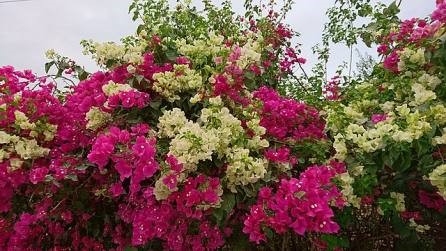Bougainvillea
 Common Names: Paper flower, bougainvillea
Common Names: Paper flower, bougainvillea
Scientific Name: Bougainvillea spectabilis
Climate: Warm, temperate, and cold
Plant description: A climbing shrub that is about 1 to 12 m high, evergreen in rainy climates, and deciduous (sheds its leaves annually) in areas that have a dry season. It has dark green leaves, small white flowers surrounded by colorful, paper-like parts that look like petals but are actually leaves. There are two varieties: single-flowered and double-flowered. The woody trunk tends to curl up, and its thin branches have sharp thorns and dark green leaves. Bougainvillea grows very well in hedges, arches, or bushes in the ground and in pots.
It is a plant native to South America, that grows from Brazil to Ecuador and to southern Argentina. While there are a variety of bougainvillea that are natural hybrids, most of the current species are the result of inbreeding among 3 of the 18 original South American species, and there are currently more than 300 varieties.
Cultivation: Bougainvillea needs to be in full sun. It needs regular watering but does not tolerate too much water, and it tolerates moderate drought well once established.
It adapts to almost any well-drained soil, but it's favorite is clayey and slightly acidic soil. It has a high tolerance to salinity. It must be fertilized at least once a year but during the flowering season it is recommended to do it once a month.
The Bougainvillea’s root system is very fine and should be planted in well drained soils. Avoid soil with high levels of peat and water retention. They retain too much water and contribute to root rot.
Bougainvillea can be propagated by cuttings that have produced roots or by layers. Both are easy to do. But you have to be careful with the roots as they are very sensitive. You can make cuttings of semi-mature cuttings in the middle or late summer or cuttings of hardwood in the middle of winter. Both require hot and humid conditions (18-21 °C).
To transplant the rooted cuttings to their final location, a hole must be dug twice as deep and twice as wide as the root ball, add fertilizer to the hole, place the cutting and cover it with soil. Compact the soil around the plant once it is in the hole, water it abundantly.
You can also sow it in pots. Fill the pot with half sand and half dirt. Place the pot in a warm place out of direct sunlight. Water it. When new leaves appear along the stem it is the sign that the roots have formed. Follow the same steps as for semi-mature cuttings.
For layer reproduction, it is necessary to bend a growing stem towards the ground and anchor. Find a stem that is producing new growth, fold it down until it touches the ground, cut it slightly on the underside, bury the part of the injured stem in the ground and fix it with a stone. Layers should start in the spring. Check in late summer to see if the roots have developed. Once they have done so, cut the stem of the mother plant, dig out the part that has roots and plant it carefully in its new location.
If you want a structure for the plant to climb, you should place it as close as possible to the plant and gently wrap the new shoots so that the structure is their support. Once established, prune it to maintain the shape, trimming the smallest branches.
 Uses: Although the strongest medicinal properties are found in the leaves, the flowers, stems, bark and roots are also medicinal. The leaves have anti-inflammatory, anti-diabetic, anti-microbial and anti-fertility properties, and can be effective against diarrhea, cough and sore throat. The leaves have antimicrobial properties and can be boiled to help reduce levels of bad cholesterol, used as an antioxidant, or as a mild analgesic, help with blood clots, protection against ulcers, and inflammation. Taking leaf infusions in large quantities can be bad for liver and kidney function with lots of use.
Uses: Although the strongest medicinal properties are found in the leaves, the flowers, stems, bark and roots are also medicinal. The leaves have anti-inflammatory, anti-diabetic, anti-microbial and anti-fertility properties, and can be effective against diarrhea, cough and sore throat. The leaves have antimicrobial properties and can be boiled to help reduce levels of bad cholesterol, used as an antioxidant, or as a mild analgesic, help with blood clots, protection against ulcers, and inflammation. Taking leaf infusions in large quantities can be bad for liver and kidney function with lots of use.
The bark has properties that are effective in treating diabetes because it has substances that create an insulin-like effect. Boiled dried stems can also help in treating hepatitis. The flowers themselves are edible and can be used raw or cooked, as well as in beverages. Drinking tea from the flowers is effective in helping with coughs, sore throats, flu, fever, and asthma.
Pests and diseases: Bougainvillea is resistant to the majority of plagues and diseases. However, you can find bougainvillea caterpillars. They have natural predators such as birds thus attracting these animals might be very useful. However, if it gets out of control the plant should be sprayed with Neem Oil.
Aphids, citrus mealybug and giant whiteflies - a hard jet of water from the hose will knock these insects off the plant. If they persist, create an insecticide that contains 1 tablespoon of dishwashing soap added to 1 cup of vegetable oil. Add 1 1/2 teaspoons of the solution to 1 cup of warm water to a spray bottle and spray the insecticide directly on the insects.
References:
https://www.bgi-usa.com/bougainvillea-101/
https://garden.org/frogs/view/9679/
En español: Bugambilia
